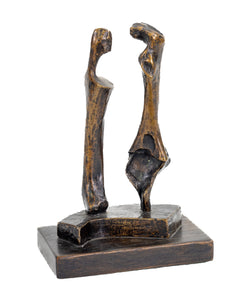
| Current Henry Moore Inventory | Recent Henry Moore Sales |

Henry Moore

Henry Moore: A Legacy in Stone and Bronze
Henry Moore (1898–1986) was a preeminent British sculptor whose innovative and monumental works established him as one of the most influential figures in twentieth-century art. Born in Castleford, Yorkshire, Moore demonstrated an early aptitude for drawing and design, which led him to study at the Leeds School of Art and later at the Royal College of Art in London. His early exposure to classical sculpture, combined with his interest in non-Western art and folk traditions, shaped a visual language that merged abstraction with a profound sensitivity to the human form.
Moore first gained international attention in the 1930s with his semi-abstract representations of the reclining figure, characterized by fluid, organic forms and a keen attention to volume and void. Drawing inspiration from nature, bones, and pre-Columbian sculpture, Moore developed a distinctive vocabulary of undulating, abstracted shapes that conveyed both strength and serenity. He often carved directly into stone or modeled in clay before casting in bronze, a process that emphasized the tactile and monumental qualities of his work.
During World War II, Moore was commissioned as an official war artist to document the effects of the Blitz on London. His drawings of sheltering civilians and bombed buildings demonstrated his mastery of observation and his ability to communicate human vulnerability and resilience. These works foreshadowed the humanistic focus that would continue to define his sculpture throughout his career.
Moore’s postwar career was marked by the creation of large-scale public sculptures that transformed urban and natural landscapes worldwide. Iconic works such as Reclining Figure (1951) and Large Divided Oval: Butterfly (1985) exemplify his interest in the interplay of mass and void, while installations in open-air settings invite viewers to experience the sculptures from multiple perspectives. His work is held in the collections of major institutions including the Tate Gallery, the Museum of Modern Art in New York, the Art Institute of Chicago, and the National Gallery of Art in Washington, D.C.
Throughout his lifetime, Moore received numerous awards and honors, including the International Sculpture Prize at the Venice Biennale in 1948, election to the Order of Merit in 1963, and appointment as a Companion of Honour in 1973. His legacy endures not only in his sculptures and drawings but also through the Henry Moore Foundation, established in 1977 to support research, exhibitions, and preservation of his work.
Moore’s contributions to modern sculpture extend beyond his own practice, influencing generations of artists and shaping public expectations of monumental art. His innovative approach to abstraction, his ability to harmonize organic form with human experience, and his commitment to making sculpture accessible to the public affirm his position as a central figure in twentieth-century art history.
Subscribe to our newsletter to get an instant alert when we add the next piece by Henry Moore
| Current Henry Moore Inventory | Recent Henry Moore Sales |